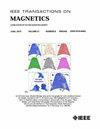Modeling Non-Linear and Non-Stationary Magnetic Signals: An Enhanced Signal Processing Strategy for Wind Time Series Analysis
IF 1.9
3区 工程技术
Q3 ENGINEERING, ELECTRICAL & ELECTRONIC
引用次数: 0
Abstract
The magnetic-flux-based condition monitoring techniques are becoming increasingly popular due to their advantages, such as non-invasiveness, low costs, and ease of sensor installation. However, developing diagnostics and prognostics-based condition monitoring systems becomes challenging as magnetic signals-based wind time series exhibit non-linear and non-stationary characteristics due to being subjected to diverse combination of dynamic system behavior. The present data-driven feature extraction techniques, as well as knowledge-based and parameter estimator models, fall short in effectively quantifying these characteristics due to increased signal complexity and computation cost. Additionally, methods like the short-time Fourier transform that assumes stationarity of signals and has a fixed window size and discrete wavelet transform that has pre-defined wavelet bases have proven suboptimal for analyzing non-linear and non-stationary magnetic flux signals due time-frequency resolution tradeoffs. This research bridges the gap by investigating a new methodology of feature extraction to adeptly process the non-linear and non-stationary behavior in magnetic signals-based wind time series. This methodology is unique in nature since it utilizes magnetic signature-based fault condition indicators derived from the wind generator of a drive train model that accounts for the electromagnetic coupling. Additionally, the signal processing technique employed here considers non-linearity and non-stationarity that arises from wind characteristics, gearbox dynamics, and grid conditions and its effects on the magnetic flux density of the wind generator. Notably, this methodology offers new insights on motivation, applications, and significance of magnetic-flux-based condition monitoring techniques and highlights its potential as a critical tool for non-invasive fault detection on multiple components of a wind turbine.非线性非平稳磁信号建模:一种用于风时间序列分析的增强信号处理策略
基于磁通的状态监测技术由于其非侵入性、低成本和易于安装传感器等优点而越来越受欢迎。然而,开发基于诊断和预测的状态监测系统变得具有挑战性,因为基于磁信号的风时间序列由于受到动态系统行为的多种组合而表现出非线性和非平稳特征。目前的数据驱动特征提取技术,以及基于知识和参数估计器的模型,由于增加的信号复杂性和计算成本,在有效量化这些特征方面存在不足。此外,短时傅里叶变换(假设信号平稳且具有固定窗口大小)和离散小波变换(具有预定义小波基)等方法,由于时频分辨率的权衡,已被证明不适合分析非线性和非平稳磁通信号。本研究通过研究一种新的特征提取方法来熟练地处理基于磁信号的风时间序列的非线性和非平稳行为,从而弥补了这一差距。这种方法在本质上是独一无二的,因为它利用了基于磁特征的故障状态指标,这些故障状态指标来源于考虑电磁耦合的传动系模型的风力发电机。此外,本文采用的信号处理技术考虑了风特性、齿轮箱动力学和电网条件及其对风力发电机磁通密度的影响所产生的非线性和非平稳性。值得注意的是,该方法为基于磁通的状态监测技术的动机、应用和意义提供了新的见解,并突出了其作为风力涡轮机多个组件非侵入性故障检测的关键工具的潜力。
本文章由计算机程序翻译,如有差异,请以英文原文为准。
求助全文
约1分钟内获得全文
求助全文
来源期刊

IEEE Transactions on Magnetics
工程技术-工程:电子与电气
CiteScore
4.00
自引率
14.30%
发文量
565
审稿时长
4.1 months
期刊介绍:
Science and technology related to the basic physics and engineering of magnetism, magnetic materials, applied magnetics, magnetic devices, and magnetic data storage. The IEEE Transactions on Magnetics publishes scholarly articles of archival value as well as tutorial expositions and critical reviews of classical subjects and topics of current interest.
 求助内容:
求助内容: 应助结果提醒方式:
应助结果提醒方式:


